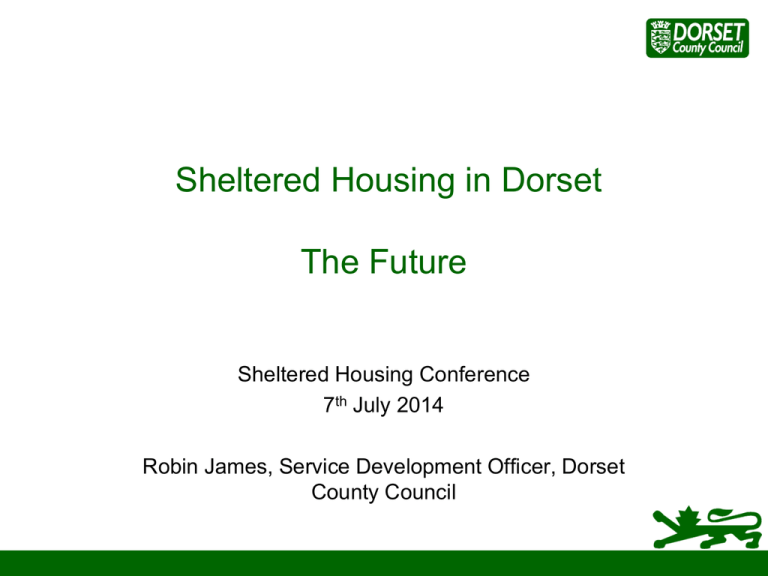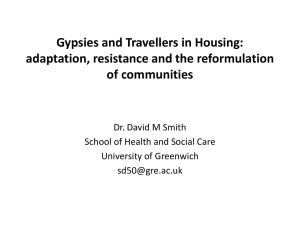Sheltered Housing in Dorset - the future
advertisement

Sheltered Housing in Dorset The Future Sheltered Housing Conference 7th July 2014 Robin James, Service Development Officer, Dorset County Council Older Peoples Housing Plan Priorities • The need to provide high quality information and advice services for older people • The provision of decent, accessible, warm and safe homes for older people • Promoting independence • Increasing housing choice Sheltered Housing Schemes The Specification They are seen as a mutually supportive environments: providing safe and secure homes for older and vulnerable people, maintaining their health, wellbeing and independence for as long as possible, thus ensuring that they do not need to seek more institutional forms of accommodation Older Peoples Housing Plan Sheltered Housing (1) Current challenges - to: • Identify effective ways of meeting the needs of a diverse group of people with ages ranging from 51 to 101+ including a number of people still in full time employment and some people with challenging behaviour including former street homeless people and people with mental health issues • Consider the feasibility of providers developing additional paid for services to meet the needs of services (these services complementing current support and housing management services) • Monitor the impact of welfare benefit changes on demand for sheltered housing Older Peoples Housing Plan Sheltered Housing (2) Current challenges - to: • Work with social housing providers to manage down to a smaller provision of higher quality sheltered housing, with decommissioning, upgrading or change over time of sub standard schemes. A specific target is not considered appropriate rather it is proposed that decisions are taken on a scheme by scheme basis in relation to: – Location and demand in the local market – The quality and accessibility of individual schemes for older people Older Peoples Housing Plan Sheltered Housing (3) Current challenges - to: • Review most effective use of sheltered housing considering its potential to meet the needs of younger vulnerable people and older people with challenging behaviour, whilst ensuring that other residents feel secure • Define minimum accommodation standards for the future, including space for mobility buggies, and to agree an overall decommissioning plan for sub standard sheltered housing for rent • Review mix of accommodation suitable for older people seeking to ensure that sheltered housing is not the only option • Assess the potential of some sheltered housing to shift to an Extra Care housing model SWOT - Workshop Output Considering the strengths, weaknesses, opportunities and threats facing the sheltered housing service. The Future: Care Act 2014 Duty to provide preventative services The duty to prevent need for care and support is set out in Clause 2 of the Care Act, which identifies three main strands of prevention – preventing the need for care and support, delaying needs for care and support, and reducing the needs for care and support. The Future Pathways to Independence Like all DCC directorates, Adult and Community Services faces major financial pressures over the next few years. The budget needs to be reduced by £16 million by March 2016, with further savings of at least £3-4 million likely to be needed to cope with rising costs and public demand. It is planned to fundamentally change the way things are done - maintaining high quality services for the public, but delivering them in different, more cost-effective ways. Population aged 75+ across the County Dorset Christchurch East Dorset North Dorset Purbeck West Dorset Weymouth and Portland 2011 52,410 7,680 12,600 7,190 5,310 13,160 6,480 2021 65,930 8,920 15,430 9,390 6,840 17,000 8,350 2031 85,480 10,900 19,250 12,870 8,770 22,770 10,930 % increase 2011-2031 63.1 41.9 52.8 79.1 65.2 73.0 68.6 Source: 2012-based trend projections, district level, DCC 2013 Population aged 85+ across the County Dorset Christchurch East Dorset North Dorset Purbeck West Dorset Weymouth and Portland 2011 16,200 2,500 3,900 2,180 1,540 4,140 1,930 2021 2031 21,090 31,200 2,960 4,030 5,090 7,130 2,870 4,420 2,090 3,120 5,540 8,510 2,550 3,980 % increase 2011-2031 92.7 61.2 82.7 103.1 102.5 105.5 106.3 Source: 2012-based trend projections, district level, DCC 2013 Sheltered Housing Options - Buildings Sheltered Housing Service • Current contracts run until: – October 2015 for tenants of non-LSVT providers – April 2016 for tenants of LSVT providers • Contracts can be extended Sheltered Housing Service Options From end of current contracts: 1. Continue as now – support provided to all living in designated sheltered housing 2. Revert to pre 2012/13 position - support provided to all living in designated sheltered housing plus excess hours available for people living in the wider community 3. Support tenure blind - provided to most needy 4. Service decommissioned – limited service provided by landlord 5. Service decommissioned – no service provided Sheltered Housing Service Options • Involvement with providers, service users and others to discuss options Sheltered Housing Service Options • Involvement with providers, service users and others to discuss options • Consultation on a preferred option Sheltered Housing Service Options • Involvement with providers, service users and others to discuss options • Consultation on a preferred option • Extend existing contracts to enable implementation in October 2016 The future • Pathways to Independence: • The programme will achieve this through a variety of means, including: – more use of assistive technology, such as telecare – move older people and people with learning disabilities away from residential placements to community supported living accommodation, where appropriate – Extending the use of direct payments and personal budgets Comments to: Robin James : Service Development Officer, Dorset County Council, County Hall, Colliton Park, Dorchester DT1 1XJ : 01305 225904 : robin.james@dorsetcc.gov.uk











